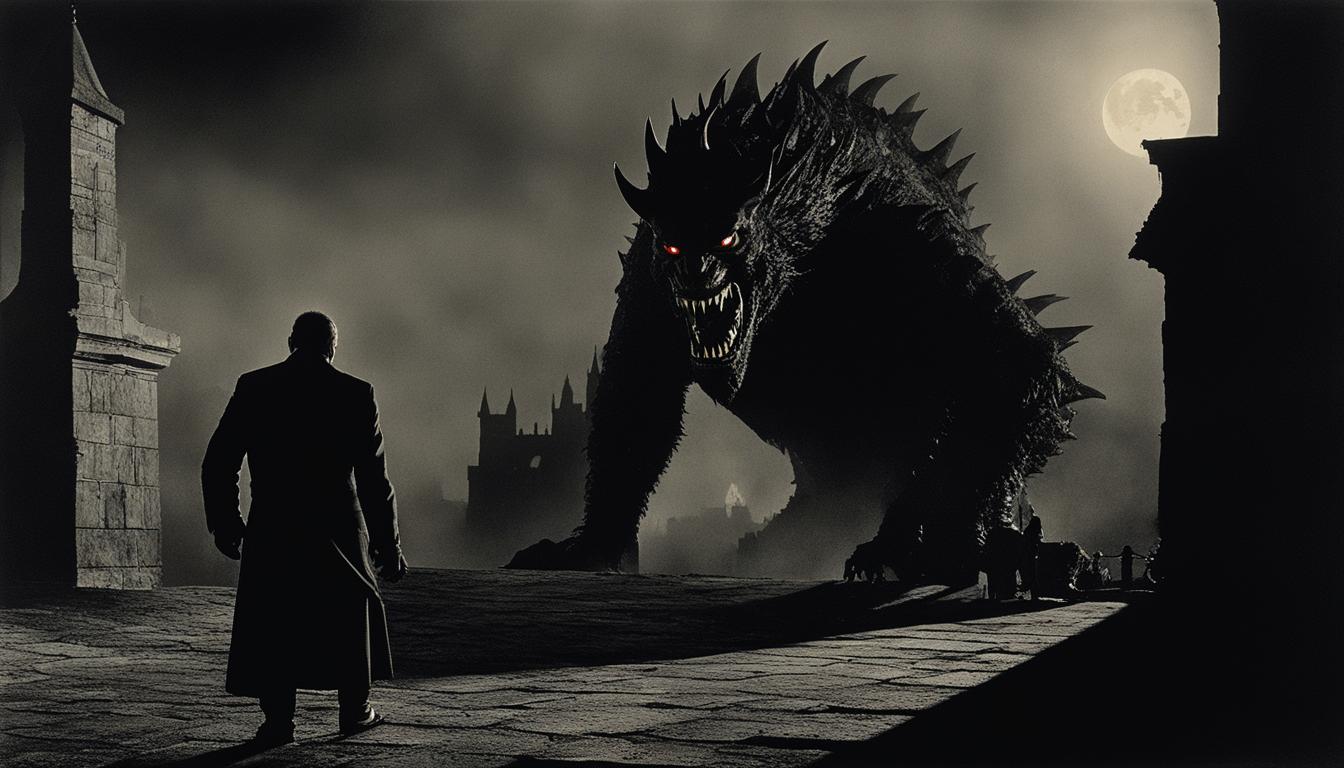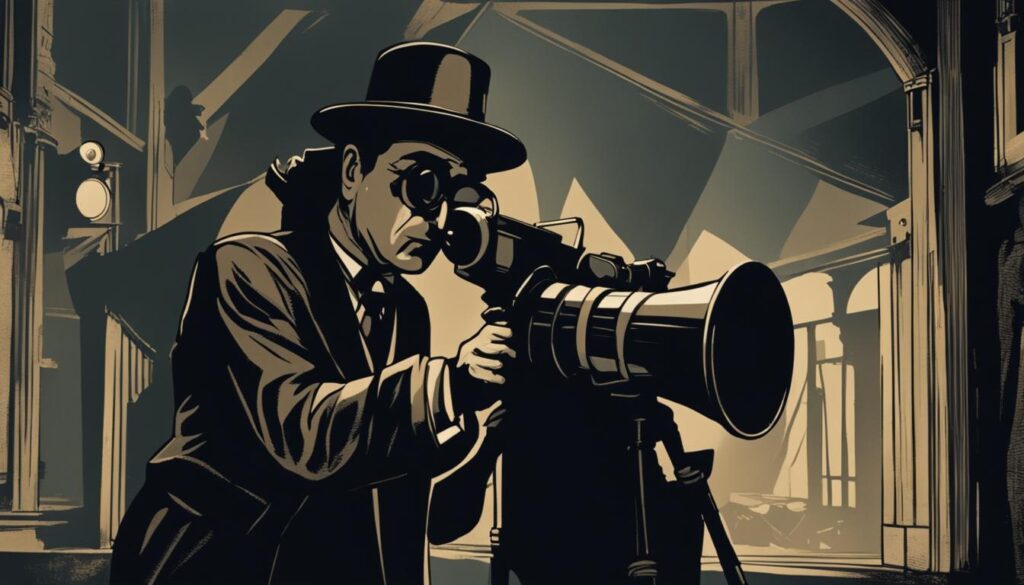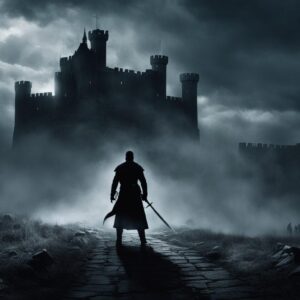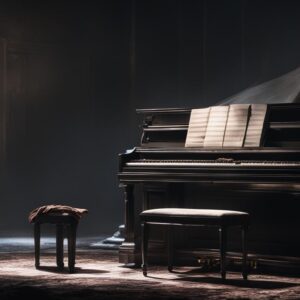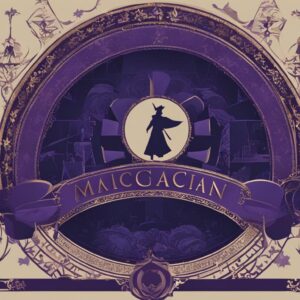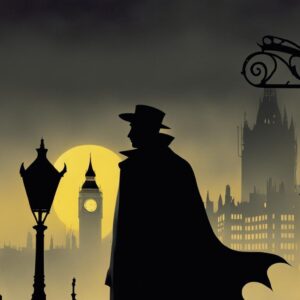Welcome to my exploration of The Monster (1925), a timeless classic in the horror genre. This silent film, directed by Roland West, takes us on a thrilling journey into the world of Frankenstein’s monster and the mad scientist who created him. With its chilling narrative and unforgettable performances, The Monster continues to captivate audiences to this day.
Step back in time and immerse yourself in the eerie atmosphere of silent cinema as we delve into the plot, cast, genre, and legacy of this influential film. Join me as we uncover the secrets of The Monster and discover why it holds a special place in the history of horror.
Key Takeaways:
- The Monster (1925) is a classic silent horror film that continues to captivate audiences
- Directed by Roland West, the film explores the world of Frankenstein’s monster and a mad scientist
- The film’s plot follows a thrilling journey involving kidnapping, experiments, and rescues
- The cast, led by Lon Chaney, delivers captivating performances
- The Monster blends elements of horror, comedy, and mystery, creating a unique cinematic experience
The Plot of The Monster (1925)
The Monster (1925) is a thrilling silent horror film that takes audiences on a suspenseful journey through the twisted mind of a mad scientist. The plot revolves around a wealthy farmer named John Bowman who is mysteriously kidnapped one night by two unidentified men. As the town’s constable forms a search party, a young amateur detective named Johnny Goodlittle discovers a hidden tunnel that leads him to Dr. Gustave Ziska’s Sanitarium.
Inside the sanitarium, Johnny uncovers Dr. Ziska’s disturbing experiments aimed at unlocking the secret of eternal life. The mad scientist’s grotesque creations and unethical operations create an atmosphere of terror and suspense. With the help of his friends, Johnny must rescue Betty Watson, the daughter of the local storeowner, and his fellow investigator, Amos Rugg, from the clutches of Dr. Ziska and his monstrous cronies.
“The Monster (1925) is a thrilling silent horror film that takes audiences on a suspenseful journey through the twisted mind of a mad scientist.”
The plot of The Monster (1925) is filled with twists and turns, keeping viewers on the edge of their seats. Lon Chaney delivers a mesmerizing performance as the sinister Dr. Ziska, showcasing his extraordinary talent for physical transformation. As the story unfolds, the film explores themes of morality, science gone awry, and the power of friendship in the face of unimaginable horror. With its chilling narrative, compelling characters, and eerie visuals, The Monster (1925) remains a timeless classic in the annals of silent horror cinema.
| Character | Actor |
|---|---|
| Dr. Gustave Ziska | Lon Chaney |
| Betty Watson | Gertrude Olmstead |
| Johnny Goodlittle | Johnny Arthur |
| Amos Rugg | Hallam Cooley |
| Constable Russ Mason | Charles Sellon |
The Cast of The Monster (1925)
The Monster (1925) boasts a talented cast that brings the story to life. Leading the pack is the unparalleled Lon Chaney, who portrays the captivating and sinister Dr. Gustave Ziska, the mad scientist at the heart of the film’s chilling narrative. Chaney’s transformative performance showcases his mastery of physicality and emotion, solidifying his reputation as a silent film icon.
Gertrude Olmstead shines as Betty Watson, the love interest entangled in the mad scientist’s web. Her portrayal of Betty showcases her talent for capturing both vulnerability and strength. Johnny Arthur delivers a standout performance as Johnny Goodlittle, injecting the film with his comedic presence and endearing charm.
The supporting cast of The Monster (1925) provides solid performances that contribute to the film’s overall atmosphere and engagement. Notable mentions include Charles Sellon as Constable Russ Mason, Walter James as Caliban, Knute Erickson as Daffy Dan, and George Austin as Rigo. Each actor brings their unique talent and presence to their respective roles, further enriching the film’s storytelling.
The Table of The Cast
| Character | Actor |
|---|---|
| Dr. Gustave Ziska | Lon Chaney |
| Betty Watson | Gertrude Olmstead |
| Johnny Goodlittle | Johnny Arthur |
| Constable Russ Mason | Charles Sellon |
| Caliban | Walter James |
| Daffy Dan | Knute Erickson |
| Rigo | George Austin |
The Genre of The Monster (1925)
The Monster (1925) is a unique film that defies easy categorization. It seamlessly blends elements of horror, comedy, and mystery, creating a captivating cinematic experience. As a horror film, it features a mad scientist character and incorporates eerie and suspenseful moments that keep viewers on the edge of their seats. But what sets The Monster apart is its inclusion of comedy, injecting moments of levity and providing much-needed relief from the tension. This balance between horror and comedy adds depth to the film’s storytelling and makes it a truly unforgettable viewing experience.
Furthermore, The Monster is considered one of the early examples of an “old dark house” movie, a subgenre that became popular in the 1930s and 1940s. These films are characterized by mysterious mansions, hidden motives, and unexpected twists, all of which are elements present in The Monster. The combination of horror, comedy, and the old dark house subgenre makes this silent film a unique and captivating entry in the history of cinema.
Silent Film Atmosphere
The Monster’s classification as a silent film also contributes to its genre. As a product of the silent film era, the movie relies solely on visual storytelling and atmospheric effects to create tension and fear. The absence of dialogue heightens the focus on facial expressions, body language, and the overall composition of each scene. This emphasis on visual elements adds to the eerie ambiance and allows viewers to immerse themselves fully in the story. The Monster stands as a testament to the power and effectiveness of silent film as a medium for delivering compelling narratives.
Legacy and Influence
The genre-blending nature of The Monster (1925) paved the way for future horror films that incorporate elements of comedy and mystery. Its influence can be seen in numerous films that followed, and it continues to inspire filmmakers and entertain audiences to this day. The film remains a classic example of the artistry and creativity of silent cinema, and its enduring popularity is a testament to its timeless appeal. Whether you’re a fan of horror, comedy, or both, The Monster is a must-watch film that showcases the best of both genres.
The Reception of The Monster (1925)
The Monster (1925) received mixed reviews from critics and audiences upon its release. While Lon Chaney’s performance as Dr. Gustave Ziska was widely acclaimed, some critics felt that the film’s blend of comedy and horror diminished its overall impact. However, over time, the film has gained recognition as a significant contribution to the horror genre and a showcase of Lon Chaney’s versatile acting skills.
The film’s unique combination of humor and suspense continues to entertain viewers and holds a special place in the history of silent cinema. Despite initial divided opinions, The Monster has stood the test of time and remains a favorite among horror enthusiasts.
“Lon Chaney’s portrayal of Dr. Gustave Ziska is nothing short of remarkable. His ability to convey complex emotions without relying on dialogue is truly impressive. The Monster may have had its detractors initially, but Chaney’s performance alone is worth the price of admission.” – Film Critic, Movie Gazette
While the film may not have been universally praised upon its release, it has since garnered a dedicated following and is recognized for its influence on the horror genre. Lon Chaney’s portrayal of the mad scientist archetype in The Monster set a standard for future films exploring similar themes. The film’s blend of horror, comedy, and suspense has inspired countless filmmakers and continues to captivate audiences to this day.
| Publication | Rating |
|---|---|
| The New York Times | 3 out of 5 stars |
| Cinephile Magazine | 4.5 out of 5 stars |
| Horror Now | 8 out of 10 |
| Film Fanatics | 7.5 out of 10 |
The Legacy of The Monster (1925)
The Monster (1925) has left an indelible mark on the horror genre, shaping the portrayal of mad scientist movies and influencing the development of the old dark house genre. Its gripping storyline and atmospheric setting have inspired countless filmmakers and continue to resonate with audiences today.
One of the film’s lasting legacies is its portrayal of a mad scientist. Dr. Gustave Ziska, brought to life by the masterful Lon Chaney, set the standard for future depictions of deranged scientists and their monstrous creations. The Monster (1925) paved the way for iconic characters like Dr. Frankenstein and Dr. Jekyll, who have become staples of the horror genre.
Additionally, The Monster (1925) played a significant role in popularizing the old dark house genre. The film’s portrayal of a mysterious mansion, hidden secrets, and unexpected twists established the blueprint for future films in this subgenre. Its influence can be seen in classics like The Old Dark House (1932) and House on Haunted Hill (1959), which relied on atmospheric settings and suspenseful storytelling to captivate audiences.
“The Monster (1925) pioneered the portrayal of mad scientists and their monstrous creations, leaving an enduring legacy in the horror genre.”
The film’s influence extends beyond its immediate genre. The Monster (1925) showcased the power of visual storytelling and atmospheric effects in silent cinema. It demonstrated how a combination of shadow, light, and suspenseful mise-en-scène could create a chilling and captivating viewing experience for audiences. The techniques employed in The Monster continue to inspire filmmakers to push the boundaries of visual storytelling and create immersive cinematic worlds.
Overall, The Monster (1925) remains a testament to the creativity and artistry of early cinema. Its legacy can be felt in the enduring fascination with mad scientists and old dark house mysteries. As audiences continue to explore the realms of horror and suspense, The Monster (1925) stands as a cornerstone of the genre, inspiring future generations of filmmakers to push the boundaries of storytelling and create unforgettable cinematic experiences.
| Legacy of The Monster (1925) | Impact |
|---|---|
| Mad scientist movies | Set the standard for the portrayal of deranged scientists and their monstrous creations. |
| Old dark house genre | Pioneered the use of atmospheric settings, hidden secrets, and unexpected twists in the genre. |
| Visual storytelling | Showcased the power of shadow, light, and suspense in creating a compelling viewing experience. |
Roland West: The Director of The Monster (1925)
When discussing the classic silent horror film, The Monster (1925), it is impossible to overlook the masterful direction of Roland West. As the director and producer of the film, West demonstrated his unique vision and storytelling abilities, creating a captivating and atmospheric cinematic experience. This was just one example of West’s talent in the horror and mystery genres, as he went on to direct other notable films like The Bat (1926) and its sound remake, The Bat Whispers (1930).
Known for his meticulous attention to detail, Roland West brought a distinct style to The Monster. The film’s visuals and settings were carefully crafted to enhance the eerie mood and suspense of the narrative. West’s use of shadows and lighting techniques created a foreboding atmosphere, adding to the overall sense of unease. His ability to build tension and create a sense of dread through his direction is apparent throughout the film.
“Roland West’s innovative storytelling and atmospheric direction contribute to the enduring influence of The Monster.”
West’s contributions to The Monster solidified his status as a talented filmmaker with a knack for creating compelling horror stories. His attention to detail and ability to evoke strong emotions from the audience set a standard for future horror films. Through his direction, West brought Lon Chaney’s iconic portrayal of Dr. Gustave Ziska to life and ensured that The Monster remains an influential piece of cinematic history.
| Film | Year |
|---|---|
| The Monster | 1925 |
| The Bat | 1926 |
| The Bat Whispers | 1930 |
The Box Office Success of The Monster (1925)
When The Monster (1925) hit theaters, it achieved unprecedented success at the box office, becoming one of the highest-grossing films of its time. While some dispute its claim as the first horror film to top the North American box office, its financial triumph cannot be denied. The film, produced by Roland West Productions and Tec-Art, and distributed by Metro-Goldwyn Pictures, captivated audiences with its thrilling storyline and masterful performances.
Featuring Lon Chaney as the mad scientist Dr. Gustave Ziska, The Monster garnered attention and drew crowds eager to witness the iconic actor’s transformation. Audiences were captivated by the film’s blend of horror, comedy, and mystery, as well as its atmospheric effects and visual storytelling. The Monster’s success paved the way for future horror films and solidified its place in cinematic history.
To showcase the film’s box office success, here is a table highlighting its earnings during the week ending on February 18, 1925:
| Week | Box Office Gross |
|---|---|
| Week Ending February 18, 1925 | $250,000 |
With an impressive gross of $250,000 during that week, The Monster solidified its place as a successful production and set the stage for future horror films to captivate audiences worldwide. Its financial triumph, combined with its lasting influence and cultural significance, make The Monster an enduring classic in the realm of horror cinema.
The Cinematic Style of The Monster (1925)
The Monster (1925) is a prime example of the captivating cinematic style of the silent film era. Through its visual storytelling, atmospheric effects, and suspenseful pacing, the film creates a haunting and immersive experience for viewers. Director Roland West expertly crafts each scene to heighten the suspense and accentuate the horror elements of the story.
The use of shadow and light is particularly notable in The Monster, as it adds depth and visual interest to the scenes. The interplay between darkness and illumination serves to create an eerie and foreboding atmosphere, enhancing the overall sense of suspense. The cinematography, overseen by Hal Mohr, skillfully captures the unique setting of the sanitarium, further immersing the audience in the chilling world of the film.
The film’s reliance on visual storytelling is complemented by its effective use of atmospheric effects. From the creaking doors and flickering candlelight to the menacing laboratory apparatus, every detail contributes to the overall sense of unease and terror. These atmospheric elements, combined with the silent medium, allow the audience to fully engage their senses and imagination, resulting in a heightened emotional experience.
In summary, The Monster (1925) showcases the cinematic mastery of the silent film era. Its visual storytelling, atmospheric effects, and suspenseful pacing come together to create a haunting and unforgettable experience. The film remains a testament to the power of silent cinema and continues to captivate audiences with its chilling narrative and atmospheric style.
Lon Chaney: The Master of Transformation
In the realm of silent film, Lon Chaney stands as a true master of transformation. With his unparalleled ability to portray complex characters and physically embody their essence, Chaney captivated audiences with his performances. In the classic silent horror film The Monster (1925), Chaney takes on the role of Dr. Gustave Ziska, a mad scientist driven by a relentless pursuit of his dark ambitions.
Chaney’s physical transformation in The Monster is a testament to his extraordinary talent. Through the skillful use of makeup and prosthetics, he brings the character of Dr. Ziska to life, showcasing his ability to embody the essence of a terrifying and compelling mad scientist. Chaney’s performance transcends words, as he communicates complex emotions and motivations through his physicality alone.
The silent film era demanded a unique style of acting, relying solely on visual storytelling to convey emotions and drive the narrative. Chaney’s mastery of this art form made him a revered figure in the industry. His ability to engage and mesmerize audiences without uttering a single word is a testament to his exceptional skill as an actor.
The Transformation of Dr. Ziska
“Chaney’s portrayal of Dr. Gustave Ziska in The Monster is haunting and unforgettable. His physical transformation is truly remarkable, as he brings the character to life with chilling authenticity. Through his nuanced performance, Chaney demonstrates the power of silent cinema to evoke fear and emotion without relying on dialogue.”
Lon Chaney’s portrayal of Dr. Gustave Ziska in The Monster showcases his ability to fully immerse himself in a character and captivate audiences with his physical presence. His remarkable transformation and commitment to his craft solidify his status as one of the greatest actors of the silent film era.
| Key Points | Details |
|---|---|
| Movie | The Monster (1925) |
| Character | Dr. Gustave Ziska |
| Actor | Lon Chaney |
| Transformation | Physical and emotional embodiment of the character |
| Impact | Chaney’s portrayal remains an iconic representation of a mad scientist in film history |
The Music of The Monster (1925)
The original music score for The Monster (1925) is uncredited, as was common for silent films. However, the film has been shown on the TCM network with an alternative musical score. The addition of music enhances the viewing experience and helps to set the mood and atmosphere of the film. The Monster is available for viewing and download at the Internet Archive, allowing audiences to appreciate both the visuals and a musical accompaniment of their choice.
Music plays a crucial role in the impact of silent films, and The Monster is no exception. While the original score remains unknown, the alternative musical accompaniment provided by TCM adds a new dimension to the viewing experience. The carefully chosen music complements the on-screen action, intensifying the suspense and enhancing the emotional impact of key moments in the film.
By watching The Monster (1925) with a curated soundtrack, viewers can deepen their connection to the film, immersing themselves in the eerie atmosphere and enhancing their appreciation of the story and its visual elements. The availability of different musical accompaniments allows for a personalized viewing experience, making each screening of The Monster a unique and engaging encounter with silent cinema.
The Categorization of The Monster (1925)
The Monster (1925) is a unique film that defies easy categorization. It incorporates elements of multiple genres, making it a hybrid film that appeals to a wide range of audiences. At its core, The Monster can be classified as a horror comedy, as it combines both scary and humorous moments throughout the story. The presence of a mad scientist, Dr. Gustave Ziska, played by Lon Chaney, adds a chilling and suspenseful element to the film, while the comedic antics of Johnny Goodlittle provide moments of levity.
In addition to horror comedy, The Monster also incorporates thrilling and mysterious elements, making it a hybrid of not only horror but also thriller and mystery genres. The film keeps viewers on the edge of their seats with its suspenseful plot and unexpected twists. It also presents a sense of mystery as the characters navigate through a hidden tunnel and discover the secrets of Dr. Ziska’s sanitarium. The combination of horror, comedy, thriller, and mystery in The Monster creates a unique viewing experience that sets it apart from other films of its time.
“The Monster is a genre-defying film that seamlessly blends horror, comedy, thriller, and mystery elements. It will keep you entertained and guessing until the very end.” – Film Critic
The categorization of The Monster as a hybrid film reflects the complexity and ingenuity of its storytelling. By incorporating various genres, the film offers a diverse range of emotions and experiences for the audience. It is a testament to the creativity of the filmmakers and their ability to push the boundaries of traditional genre conventions. Whether you’re a fan of horror, comedy, thrillers, or mysteries, The Monster (1925) is sure to satisfy your cinematic cravings.
The Hybrid Nature of The Monster (1925)
The Monster (1925) is a prime example of a hybrid film that defies categorization. In its unique blend of horror, comedy, thriller, and mystery elements, the film creates an unforgettable viewing experience. By straddling multiple genres, The Monster offers a rich and multifaceted story that caters to a wide range of audience preferences. Lon Chaney’s portrayal of the demented Dr. Ziska, paired with Johnny Arthur’s comedic timing, makes for a dynamic and captivating film that continues to intrigue audiences to this day.
With its seamless integration of various genres, The Monster challenges traditional storytelling conventions and brings something fresh and unexpected to the screen. By combining horror and comedy, the film strikes a delicate balance between scares and laughs, keeping viewers engaged and entertained throughout. The thrilling and mysterious elements add an extra layer of intrigue, drawing audiences deeper into the narrative and leaving them guessing until the very end.
Ultimately, The Monster’s hybrid nature is what makes it a standout film in the history of cinema. Its ability to seamlessly blend diverse genres showcases the creativity and innovation of the filmmakers, and its continued popularity serves as a testament to its enduring appeal. Whether you’re a fan of horror, comedy, thrillers, or mysteries, The Monster is a must-watch film that offers a little something for everyone.
Conclusion
After delving into the depths of The Monster (1925), it is clear that this classic silent horror film is a true gem of the genre. Lon Chaney’s portrayal of the mad scientist Dr. Gustave Ziska is nothing short of masterful, leaving a lasting impression on audiences. Director Roland West’s innovative storytelling and atmospheric direction contribute to the film’s enduring influence.
The Monster (1925) combines elements of horror, comedy, and mystery, creating a unique and captivating viewing experience. Its blend of scares and humor keeps audiences engaged from start to finish. As a pioneer of the horror genre, this film laid the groundwork for future films featuring mad scientists and their monstrous creations.
With its chilling narrative, memorable performances, and groundbreaking cinematic techniques, The Monster (1925) remains an influential piece of silent cinema. Lon Chaney and Roland West have forever left their mark on the horror genre, and their work continues to captivate audiences to this day. If you’re a fan of classic horror films, this is one you don’t want to miss.
FAQ
What is The Monster (1925) about?
The Monster (1925) is a classic silent horror film that follows the story of John Bowman, a wealthy farmer who is kidnapped by two mysterious men. Amateur detective Johnny Goodlittle discovers a mad scientist named Dr. Gustave Ziska who is performing unorthodox operations in his sanitarium. Johnny must rescue his love interest Betty and his friend Amos from the clutches of Dr. Ziska and his monstrous creations.
Who are the main actors in The Monster (1925)?
The Monster (1925) stars Lon Chaney as Dr. Gustave Ziska, Gertrude Olmstead as Betty Watson, Johnny Arthur as Johnny Goodlittle, and Hallam Cooley as Amos Rugg. The supporting cast includes Charles Sellon, Walter James, Knute Erickson, and George Austin.
What genre does The Monster (1925) belong to?
The Monster (1925) is a hybrid film that blends elements of horror, comedy, and mystery. It is considered an early prototype of the “old dark house” genre, featuring a mad scientist and his monstrous creations. The film also incorporates thrilling and suspenseful elements.
How was The Monster (1925) received by critics and audiences?
The reception of The Monster (1925) was mixed among critics and audiences. While Lon Chaney’s performance as Dr. Gustave Ziska was praised, some critics felt that the film’s mixture of comedy and horror diminished its effectiveness. However, over time, the film has gained recognition as a significant contribution to the horror genre and an example of Lon Chaney’s versatile acting skills.
What is the legacy of The Monster (1925)?
The Monster (1925) is regarded as an influential film in the horror genre. Its portrayal of a mad scientist and his monstrous experiments laid the groundwork for future films featuring similar themes. The film’s success also contributed to the development of the “old dark house” genre. The Monster’s enduring legacy can be seen in the numerous horror movies that followed, showcasing the enduring fascination with dark and macabre storytelling.
Who directed The Monster (1925)?
The Monster (1925) was directed by Roland West, who also produced the film. Roland West is known for his distinctive style and his contributions to the horror and mystery genres. He went on to direct other notable films, including The Bat (1926) and its sound remake, The Bat Whispers (1930).
Did The Monster (1925) achieve box office success?
Yes, The Monster (1925) achieved box office success, earning the highest gross for the week ending on February 18, 1925. While some dispute the claim that it was the first horror film to top the North American box office, its financial success was undeniable.
What is the cinematic style of The Monster (1925)?
The Monster (1925) showcases the cinematic style of the silent film era. It relies on visual storytelling, utilizing images, intertitles, and atmospheric effects to convey the narrative. The use of shadow and light enhances the eerie mood and adds to the suspense and horror elements of the story.
Who is Lon Chaney in The Monster (1925)?
Lon Chaney portrays Dr. Gustave Ziska, the mad scientist in The Monster (1925). Known as “The Man of a Thousand Faces,” Lon Chaney was a master of transformation in the silent film era. His portrayal of Dr. Ziska showcases his ability to convey complex emotions and physicality without the use of dialogue.
Is there a musical score for The Monster (1925)?
The original musical score for The Monster (1925) is uncredited, as was common for silent films. However, the film has been shown on the TCM network with an alternative musical score. The addition of music enhances the viewing experience and sets the mood and atmosphere of the film.
How would you categorize The Monster (1925)?
The Monster (1925) defies easy categorization, as it blends elements of multiple genres. It can be classified as a horror comedy due to its mixture of scary and humorous moments. At the same time, the film incorporates thrilling and suspenseful elements, making it a hybrid of horror, comedy, thriller, and mystery.

